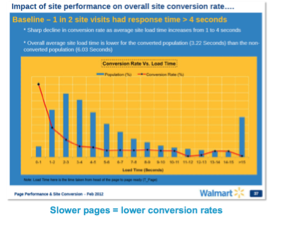By Lorenz Jakober, Senior Product Marketing Manager, Akamai Technologies

There’s no doubt that mobile shopping will be a major trend again this year. Early numbers across 30 Akamai retail customers suggest that over 30% of traffic is already coming from mobile. In addition we believe that shoppers’ in-store use of mobile devices will experience a healthy uptick this holiday season.
Recent Google research found that a growing number of customers are combining channels, with 89% of smartphone users using their smartphones while shopping in stores. Close to 70% of consumers that used a smartphone in a store used it to look at that retailer’s site and 21% used store apps. Furthermore, according to Laura Wade-Gery, executive director of Multi-channel e-Commerce for Marks & Spencer, “shoppers who shop on our website as well as in our stores spend four times as much; throw smartphones into the mix and they spend eight times as much.” This means that merchants need to combine an optimized, easy-to-use site and an in-store network infrastructure that will deliver quality web experiences to consumers’ devices quickly and reliably, and facilitate this new brick-and-mortar shopping trend.
Shoppers don’t think in terms of channels. They think about brands, and they want that same fast and efficient brand experience whether they’re on a desktop or a mobile device, on their couch or in the store aisle. They no longer make allowances for how or where they’re accessing products and services. Additionally, there’s now an expectation that the store associates will be part of this digital experience. For example, if a product or version of a product isn’t available in a store, merchants’ associates should be able to command a (ideally mobile) device and locate that product online for the customer. The interface and online pathway should be uncomplicated and nearly immediate because consumers and employees alike need the information at that moment — that’s why they go through the trouble of looking at a little screen or doing so in front of a customer about to make a sale. The experience should be equally as seamless in the store for both the employee and the customer.
This level of mobile, in-store accessibility and reliability is especially important when traffic across all channels is spiking during the holiday season due to flash sales and promotions, or just popular shopping days like Black Friday and Cyber Monday. For example, according to our Akamai Net Usage Index data, online shopping peaked on Cyber Monday last year with more than 8.5 million page views per minute at 8 p.m. ET. During these planned and unplanned spikes, retailers need to still be able to deliver these high quality experiences and absorb the traffic across all channels.
In order to manage this traffic and demands of the consumer, retailers need to deliver sites and apps that are fast, scalable and secure. Here are some tips to make sure your site is ready to accommodate mobile users this holiday season (and next):
- Adopt your customers’ perspective: Consider what the end-user experience looks like, imagine the potential situation as it relates to your website and app, and consider how that experience relates to the competition or other internet leaders.
- Optimize your network infrastructure: In-store networks often leave something to be desired. With their high latency and low bandwidth, they can have a significant impact on in-store web performance. What’s causing these slowdowns? For the most part it’s the network architecture and the type of connectivity available in those store locations.
- Make it blazing fast: Deliver consistent, fast, quality web and app experiences across all traffic conditions and situations. Accelerate the rendering of the application in the browser so it seems faster to the end-user. Some experts would argue this is the most important step to improving the mobile experience because it ensures everything is functioning as it should. Delivering the experience faster can also involve optimizing applications so they look and function exactly the same for the end user but make fewer requests over the network back to the server; and answering requests with as few bytes as possible.
- Be prepared: Don’t forget to plan for both expected and unexpected spikes in online holiday traffic, because it doesn’t matter if you’re fast if you’re not available. As far as unplanned spikes go, during the last holiday season we saw a series of coordinated DDoS attacks against retailers starting on Cyber Monday, hammering these sites with significantly higher than normal holiday traffic levels. Make sure that you design for failure, and make sure that your third party scripts are not blocking the loading of your pages.
What if you don’t think about all of these things? In other words, what happens when consumers are dissatisfied with your web site performance? According to a Compuware APM study, 49% of tablet users and 40% of smartphone users are unlikely to visit the site again. Furthermore, 33% of tablet users and 26% of smartphone users are less likely to purchase from that company. And remember — fast is better than slow — as is clearly illustrated by Walmart’s RUM data:

What other tips do you have for giving customers better connected shopping experiences? Did you make any changes in anticipation of the 2013 holiday shopping season? Share your own stories on this blog, subscribe to this blog feed, or follow #AkamaiHoliday and @Akamai on Twitter to stay in touch and learn about interesting traffic spikes we saw throughout the holiday season.
Lorenz Jakober is a senior product marketing manager at Akamai Technologies and has extensive experience in the areas of web and mobile application design, performance optimization, usability, and delivery. Prior to joining Akamai Technologies he drove mobile product marketing strategy and the complexity at the edge theme for Compuware Gomez. He is an avid spokesperson and blogger on the topic of mobile and web performance






